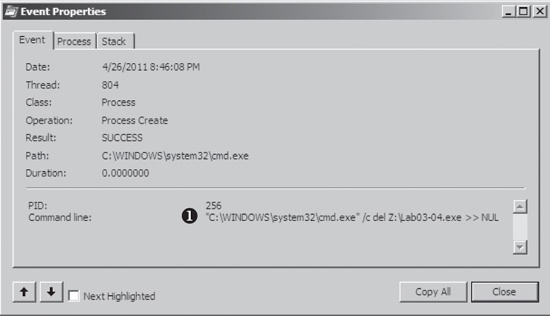When you run this malware by double-clicking it, the program immediately deletes itself.
We suspect that we may need to provide a command-line argument or a missing component to the program.
We try using the command-line parameters shown in the strings listing (like
-in), but doing so is not fruitful. More in-depth analysis is required. (We’ll analyze this malware further in the labs for Chapter 9.)
We begin with basic static analysis, examining the PE file structure and strings. We see that this malware imports networking functionality, service-manipulation functions, and registry-manipulation functions. In the following listing, we notice a number of interesting strings.
SOFTWAREMicrosoft XPS kernel32.dll HTTP/1.0 GET NOTHING DOWNLOAD UPLOAD SLEEP cmd.exe >> NUL /c del http://www.practicalmalwareanalysis.com NT AUTHORITYLocalService Manager Service .exe %SYSTEMROOT%system32 k:%s h:%s p:%s per:%s -cc -re -in
We see strings such as a domain name and the registry location SOFTWAREMicrosoft XPS. Strings like DOWNLOAD and
UPLOAD, combined with the HTTP/1.0 string, suggest that this malware is an HTTP backdoor. The strings -cc, -re, and -in could be command-line parameters (for example -in
may stand for install). Let’s see if basic dynamic techniques show us how these strings are
used.
Before we run the malware, we run procmon and clear out all events, start Process Explorer, and set up a virtual network. When we run the malware, it appears to immediately delete itself, and we see nothing else of interest while watching with Process Explorer.
Next, we use procmon with a filter on the process name Lab03-04.exe.
There aren’t any interesting WriteFile or RegSetValue entries, but upon further digging, we find an entry for
Process Create. Double-clicking this entry brings up the dialog
shown in Figure C-11, and we see that the malware is
deleting itself from the system using "C:WINDOWSsystem32cmd.exe" /c del
Z:Lab03-04.exe >> NUL, as seen at ❶.
We can try to run the malware from the command line using the command-line options we saw in
the strings listing (-in, -re,
and –cc), but all of them fail and result in the program
deleting itself. There isn’t much more we can do with basic dynamic techniques at this point,
until we dig deeper into the malware. (We will revisit this malware in the Chapter 9
labs.)

